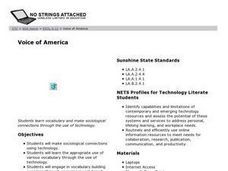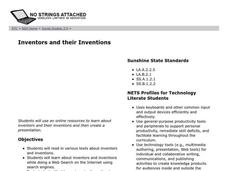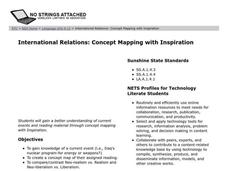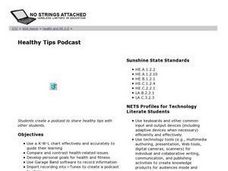Curated OER
European Newscast
Students work in cooperative learning groups to create and perform a newscast about a European country. This geography-based technology instructional activity concludes with class presentations and student critiques.
Curated OER
Voice of America
Students explore the English Language using interactive links, web-based research, and socialogical articles. The lesson ends with each student sharing their responses about the articles to the class.
Curated OER
You Are What You Eat!
Students evaluate information on various websites in relation to health concepts and healthy dieting in this technology-based High School Health lesson. Emphasis is placed on the use of small cooperative learning groups and the creation...
Curated OER
Occupational Outlook
Students analyze collected data to determine the occupational outlook for a variety of careers. This social studies lesson plan for the high school classroom is ideal for student practice using spreadsheet software, internet access, and...
Curated OER
Inventors and their Inventions
Students create a PowerPoint or Keynote presentation on a specific inventor and their invention. This lesson is web-based and includes resource links, alternative lesson ideas, and lesson extensions.
Curated OER
Discovering the Oasis
Students focus on the types of vegetation and animal life living around local water sources. This lesson can be adapted to any local water source, whether it be a lake, a river, stream or ocean. It has a particular focus on the bird...
Curated OER
People Of The Plains
Students engage in a lesson that discusses how Native Americans lived in all different parts of North America. They focus on investigating the region's natural resources and how the indians used them to build shelter, make clothing, and...
Curated OER
Discovering Dinosaurs
Students research facts about dinosaurs and practice effective speaking strategies by creating a Keynote or PowerPoint presentation in this Science and Language Arts instructional activity for the upper-elementary classroom. It includes...
Curated OER
International Relations
Students compare and contrast Neo-realism vs. Realism and Neo-liberalism vs. Liberalism using computers, the internet, Inspiration educational software, and concept maps. This lesson includes a short lesson description and video clip.
Curated OER
Dollars for Darfur
Students send emails to famous people, politicians, and local media services in an effort to inform others of the current situation in Darfur. This includes internet research and a video example of the lesson.
Curated OER
Poetry Movies
Students research, analyze, and describe a poem using the Internet and a variety of technology applications in this Language Arts lesson for the High School classroom. Emphasis is placed on the creation of a Keynote or PowerPoint...
Curated OER
Healthy Tips Podcast
Students create a health-based podcast for peers using prior knowledge, internet research, and KWL charts. This instructional activity is adaptable for different health topics and age levels.
Curated OER
National Parks
Students create national park brochures on selected endangered animals using research information, hand-drawn pictures, and the Pages and KeyNote software programs. This lesson was written for a TAG classroom.
Curated OER
Sea World Fieldtrip Follow-up
Students create a graphic organizer in preparation for a web page about a specific science-related topic. This lesson is used as a follow-up to a field trip experience and can be adapted for many different subjects.
Curated OER
Florida the Best WebQuest
Learners create a multimedia presentation demonstrating that Florida is the Best State in this creative project for the early elementary classroom. The lesson can be adapted for any state or country.
Curated OER
State Research
Students apply previous knowledge of the United States to label a classroom map and then work independently to complete an online scavenger hunt. This lesson is intended for an upper-elementary classroom studying American History and/or...
Curated OER
International Relations: Concept Mapping With Inspiration
Students create concept maps comparing and contrasting Neo-realism vs. Realism and Neo-liberalism vs. Liberalism using the Inspiration educational software. This lesson is intended for a high school level social studies class and...
Curated OER
The Cost of Progress
Students examine the cost of progress from the 1500's to the 1800's around the world and create informative websites based upon their research. This lesson is intended for a high school World History class and uses the Keynote...
Curated OER
Face It!
Learners experiment with proportions and drawing in this excellent Art lesson for grade 5-8. The lesson includes a PowerPoint slide show and requires the use of the educational software entitled "MatchWho". Students are required to use...
Curated OER
Coordinate Plane Transformations
Geometric transformations are explored by high schoolers. They will create a set of instructions for plotting coordinates representing an original transformation of a real-world figure. These instructions are shared with middle...
Curated OER
Wheel of Fortune for Students with Multiple Disabilities
Students play Wheel of Fortune. In this Wheel of Fortune lesson, students with disabilities play an online version of the game to earn rewards and small prizes. Students must solve math problems correctly in order to win.
Curated OER
Wellness Inventory
Eighth graders evaluate their own health status. For this health science lesson, 8th graders complete a worksheet of wellness inventory. They design an improvement plan for themselves.
Curated OER
Measurement: When Degrees Matter
Eighth graders record the temperature change of the beakers. In this general science lesson plan, 8th graders create their own data table for recording observations. They discuss experimental results and cite real life applications.
Curated OER
Rock Identification Lab
Eighth graders compare and contrast the three different types of rock. In this earth science instructional activity, 8th graders classify rock samples according to their correct rock type. They design their own data collection table.























